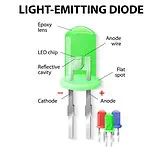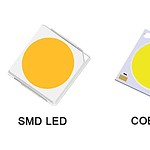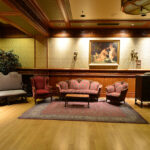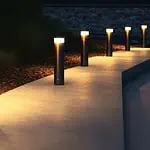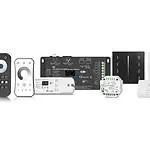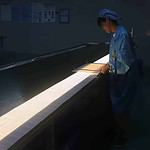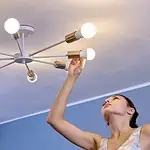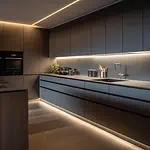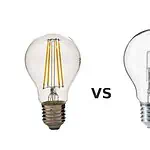Have you ever thought that the size of the base of a bulb can be a crucial consideration while buying fixtures? E26 bulb is one of the most common bulb bases considered standard in the US and widely used for residential and commercial applications.
E26 bulb refers to the Edison screw fixtures with a 26mm diameter base. Any bulb with such a base is known as an E26 bulb; it can be a globe bulb, sphere bulb, pear-shaped bulb, or fixture of some other variant. You can find them as incandescent, halogen, CFL, or LED bulbs. Besides smart lighting features are also available in these bases. The major benefit of using E26 bulbs is that they are standardized sizes and are compatible with the built-in sockets of houses or offices. Plus, they are easy to install, and you can easily retrofit an incandescent E26 socket with an LED bulb.
So, without further delay, let’s get into E26 bulbs in depth to learn what they are, their application, and how they work. I have also added a guideline for purchasing a suitable E26 bulb for your convenience. Here you go-
What Is An E26 Bulb?
E26 bulb is any bulb or lamp that has an Edison screwing cap or base of 26mm diameter for mounting and electrical contact. They are also known as Medium Edison Screw bulbs (MES) or standard bases and are mostly popular in the United States, Canada, and other North American countries. Remember, E26 defines the bulb base, not the entire bulb. Two E26 bulbs may look different but have the same base, which is compatible with the E26 bulb socket. However, identifying these bulbs is super easy. Each of the E26 has a metal screw base and is one inch in diameter. So you can identify them without requiring any specifications or consultancy.
The E26 bulbs originated in the late 19th century when various incompatible bases were used for incandescent lamps in the United States. Thomas Edison designed the screw base in 1880, inspired by a kerosene can lid. In 1892, the merger of Edison General Electric with Thomson-Houston formed General Electric, further popularizing the Edison screw. This Edison base, with a 1-inch diameter and seven threads per inch, later evolved into the E26 standard. By 1908, it became the most common base in the US. International standardization of Edison screws began in 1918, resulting in two standards—one for Europe and one for the Americas—endorsed by the International Electrotechnical Commission (IEC) in 1930 and 1931. And till today, E26 is one of the most used Edison screw bases.
What Does ‘E’ Stand For?
The letter’ E’ in the E26 bulb stands for Edison Screw. This initial refers to Thomas Edison, the inventor of the incandescent light bulb and the Edison screw base. By this ‘E’ letter, it indicates that the bulb uses an Edison screwing mechanism. And so you will need a bulb that is compatible with this screwing; having a pin system bulb will not fit in an E26 socket.
What Does The ‘26’ Mean?
The number ’26’ in E26 bulbs indicates the diameter of the bulb base. The base of the E26 bulb is exactly 26mm in diameter. So, if you have an E26 socket, you will need bulbs with a base of 26mm diameter. Remember, this measurement is not of the entire bulb but of just the base; the bulb can be much bigger.
How Does An E26 Bulb Work?
The basic mechanism of an E26 bulb is to pass electricity from the power source to the E26 base and from the base to the light bulb. Just like any other bulb, when the E26 bulbs come in contact with electricity, they start to glow, but correct wiring is important here. The base of the E26 bulb has a metallic contact point of 10mm in diameter. This contact point acts as the “hot” or “live” electrical input. Above this point, the screwing of the bulb goes on, that is, to fit the socket. When you mount the bulb to the socket by rotating it clockwise, it fully secures and connects to each other. This builds electrical contact points and gives mechanical support to the bulb to stay fitted to the socket.
The screw threads inside the bulbs are right-hand threads, and electrical wires are soldered or welded onto the screw. These threads act as neutral electrical paths and pass the electricity from the socket to the filament of an incandescent or halogen bulb. And when the filaments come in contact with electricity, they get hot and thus produce light. However, LED & CFL bulbs don’t have filaments in them. So, in these E26 bulbs, light is generated as electricity passes through their internal components. For instance, when electricity enters an E26 CFL bulb, mercury and argon fumes inside the bulb produce invisible ultraviolet (UV) light. This causes the phosphor coating inside the CFL bulb to glow. On the other hand, in E26 LED bulbs, the light-emitting diodes are responsible for producing light. However, to learn more about the working mechanism of LEDs, you can read this article- LED Strip Light Internal Schematic and Voltage Information.
Advantages Of Using E26 Bulbs
E26 bulbs are not only popular but also have many reasons for their massive usage. Here are the advantages that E26 bulbs offer-
Widespread Compatibility
In the United States, the E26 bulb is considered the standard bulb size, so you will get this readily available anywhere. This removes the bulb compatibility issues many times; you will not need to think much while choosing an E26 bulb. Apart from these, these bulbs are cross-compatible with other similar bulb sizes like E27. so, by chance, if you get the wrong base size, which is close to E26, it may still fit the socket.
Versatility
E26 bulbs are available in versatile lighting technologies, including incandescent, LED, and CFL. This helps you to choose according to your needs. However, LED E26 bulbs are mostly used for their high energy efficiency. Yet, for aesthetic lighting, you can also select incandescent E26 bulbs.
Easy Installation & Switching
To install E26 bulbs, you need no professional help. You can quickly understand the screwing system of the bulb. All you need to do is align the screw threads with the fixture socket and rotate the bulb clockwise until it is securely in place. And if your fixture burns out or doesn’t work, you can also easily remove and replace it with a new one.
Highly Stable Bulb Fitting
The screwing system secures the fixture tightly to the socket. So, it doesn’t matter how vibrating the area of your fixture installation is; there is no chance of it falling off. This ensures your light bulb is not physically harmed or breaks down by falling.
Easily Upgradable to LED
Another major benefit of the E26 bulb is that you can upgrade the incandescent ones to LED. That is, modification is possible with E26. Thus, you can enjoy the energy efficiency and durability of LED technology.
Smart Features Availability
Most smart bulbs on the market are designed to fit into the E26 bulb size, making them easy to use almost anywhere. Compared to regular bulbs, these smart bulbs can be very useful and adaptable. To begin with, you can use voice assistants like Alexa and Google Assistant to control them. You can further adjust the power toggle, brightness, and color temperature with the help of such a smart assistant.
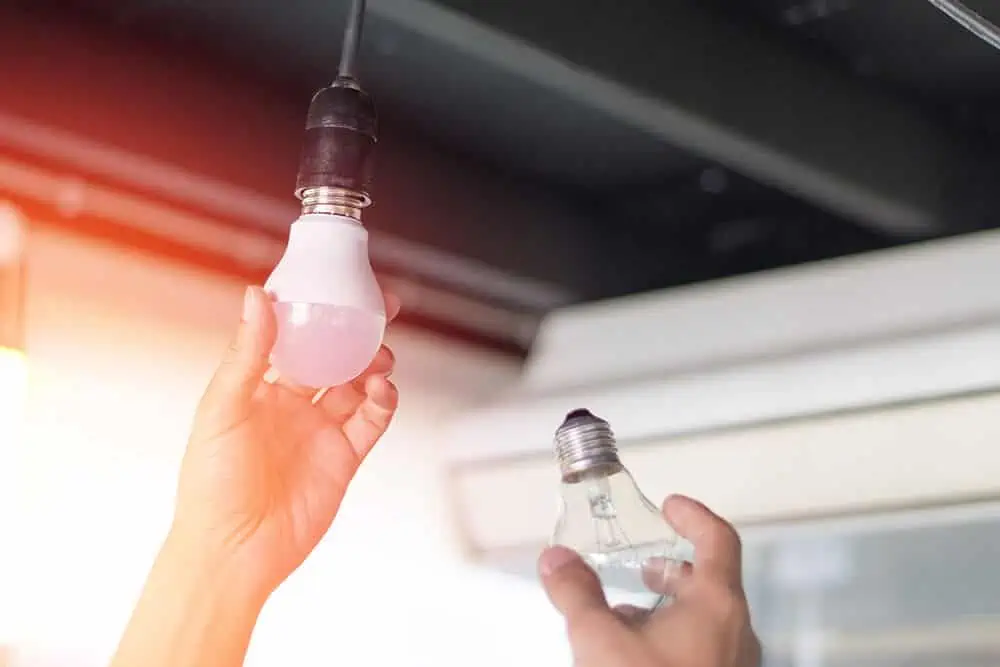
Types Of E26 Bulbs
E26 bulbs can be a category of the base, not the main bulb that illuminates. The bulb of an E26 base can be incandescent, halogen, CFL, or LED. Whatever the bulb technology is, the common fact here is all of these bulbs will have a metallic screw base of 26mm diameter that fits an E26 socket. Here are details of these bulbs-
Incandescent E26 Bulb
Incandescent lights are traditional fixtures with a tungsten filament that produces light when heated by an electric current. These light bulbs give off a warm orangish glow that imitates the illumination of candles. However, these fixtures are not energy-efficient and last 1000 hours on average. You can use E26 halogen bulbs to bring aesthetic appeal to your room, but it will surely cost you more while paying electricity bills.
| Pros | Cons |
| Low initial costProvides a warm and welcoming glowInstant brightness; no warm-up time is required | Low energy efficientShot lifespanNot environment friendly |
Halogen E26 Bulb
Like incandescent E26 bulbs, halogen bulbs also have tungsten filaments. But the difference here is that it contains halogen gas like iodine or bromine within the bulb. The usage of this gas extends the lifespan of the tungsten filament, makes the bulb more efficient, and lasts longer. However, regarding light color, they usually produce warm white lighting similar to natural daylight. These bulbs usually last up to 2000 hours on average.
| Pros | Cons |
| Have dimmable optionBright white lightingMore compact compared to incandescent bulbs | Overheating issuesNot environment friendly Low energy efficiency May not be suitable for all region |
CFL (Compact Fluorescent Lamp) E26 Bulb
CFL E26 bulbs use fluorescent lighting technology to illuminate light. These fixtures are designed to replace traditional incandescent lighting as they produce similar illumination, consuming much less energy. These bulbs contain a small amount of mercury vapor and phosphor coating inside. When electricity flows through the gas, it produces ultraviolet (UV) light, which then interacts with the phosphor coating to create visible light. However, these bulbs require a short warm-up time to glow.
| Pros | Cons |
| More energy efficient compared to incandescent and halogen W26 bulbsLonger lifespan than incandescent bulbs | Emits UV rayBulkier in shapeComplex recycling |
LED (Light Emitting Diode) E26 Bulb
LED E26 bulbs are the most energy-efficient variants. They don’t have any tungsten filament like incandescent or halogen bulbs. Instead, these fixtures use light-emitting diodes to produce light. One of the most essential features of these LED bulbs is that they have a longer lifespan and can last from 50,000 hours to 100,000 hours. So, using these bulbs will not require frequent replacement. Besides, they consume about 80% less energy than traditional fixtures like incandescent. All these facts make LED E26 the best choice for daily use.
| Pros | Cons |
| Contains no harmful gasCool operation Highly energy efficientVersatileDurable & longer lifespanSmart lighting feature is available | Higher initial cost May have compatibility issues with certain dimmer switch |
Comparison Between Different Types Of E26 Bulbs
| Criteria | Incandescent E26 | Halogen E26 | CFL E26 | LED E26 |
| Brightness | 15 lumens per watt | 25 lumens per watt | 60 lumens per watt | 72 lumens per watt |
| Annual Operation Cost/bulb | $7.01 | $5.50 | $1.75 | $1.19 |
| Lifespan | 1000 hours | 2000 hours | 10,000 | 50,000-100,000 |
| %more efficient than incandescent bulb | – | 28% | 75% | 80% |
| Cold Tolerance | Yes | Yes | Somewhat | Yes |
| Dimmable | Yes | Yes | Some | Most |
| Instant On | Yes | Yes | Most | Yes |
| Contains Mercury | No | No | Yes | No |
Is E26 Bulb a Standard-Sized Bulb?
Yes, the E26 bulb has a Medium Edison Screw base and is a standard-sized bulb in the USA. Though there are other bulb bases like E39, E12, and E17, the E26 brings a balance between the bulb base sizes. Its size is regulated by ANSI or the American National Standards Institute, so you will find consistency in the base sizes everywhere you go. In most of the home appliances in the US, an E26 bulb socket is used.
Another important reason for the E26 being a standard-size bulb is that it comes in all shapes and sizes, having the same socket type. You will find almost an E26 variant for any type of fixture, including globe bulbs, sphere bulbs, smart bulbs, and incandescent bulbs.
E26 Standards and Dimensions
The International Electrotechnical Commission (IEC), under standard 7004-21A-2, determines the standards for E26 bulbs. They govern the accuracy of dimensions of the E26 bases so they are manufactured perfectly. The dimensions of the E26 bulb are as follows-
| T1: Minimum dimension of 19.56 mm. |
| T: Minimum dimension of 19.56 mm. |
| H: Minimum dimension of 9.14 mm and a maximum dimension of 11.56 mm. |
| L: Minimum dimension of 15.24 mm and a maximum dimension of 17.01 mm. |
| C: Minimum dimension of 3.25 mm. |
| r: Radius of 1.191 mm. |
| d1: Diameter of 24.72 mm. |
| d: Minimum diameter of 26.05 mm and a maximum diameter of 26.41 mm. |
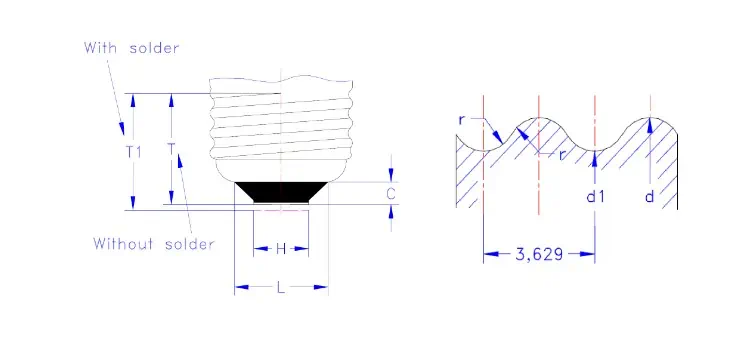
Things to Consider Before Buying an E26 Bulb
E26 bulbs can be of various types based on different criteria. For instance, if you consider technology, they can be incandescent, halogen, CFL, or LED. Again, considering bulb shape, they can be sphere bulbs, globe bulbs, etc. Likewise, you need to consider a lot of things when picking the best one for your application. So, I have listed some major considerations that you must look at before buying an E26 bulb-
Base Type
Before purchasing any bulb, consider its base. If you have an E26 socket at your home, the bulb you choose must have the base of the same category. Whatever fixture you choose, globe light, incandescent, sphere light, or something else, check its specifications. Look for the E26 base in the packaging to confirm it is ideal for your application.
Bulb Type Or Technology
E26 bulbs can be of different types and technology. It can be incandescent, halogen, CFL, or LED. Decide which one is best for your space. Undoubtedly, I suggest you choose E26 LED bulbs. They are highly energy efficient and last much longer compared to other variants. Besides, these bulbs operate at low temperatures without emitting much heat. They are also environment friendly as there is no toxic gas content in them like halogen or CFL bulbs.
Shape & Size Of The Bulb
E26 bulbs can be of different shapes, like spherical, globe, pear-like, etc. You need to consider which design of light you want. For instance, if you want globe E26 bulbs, there are options like- G25, G30, G40, G50, etc. All these bulbs will have the same E26 base, but the size of the bulb will vary. Likewise, you will get lots of options in choosing other patterned bulbs. So, decide what shape and size you want for an E26 base and then purchase one accordingly.
Wattage and Brightness
The wattage and brightness are crucial considerations in determining the lighting output of the E26 bulb. At low-wattage draw, E26 LED lights can produce more brightness, which makes them the ideal choice. For instance, an E26 incandescent bulb produces 15 lumens per watt, whereas an LED one can produce 72 lumens per watt. That is, for the same wattage rating, you will get far brighter light with LED light. This will surely help you in saving your electricity bills.
Voltage
The E26 bulls are designed to use 120V AC in the North American market. However, it can also be 240V AC in regions other than North America. Actually, the voltage depends on the manufacturers and the regional guidelines. So, based on your location, get the voltage that matches your power outlet.
Color Temperature
E26 incandescents are known for their yellowish traditional lighting. These lights are not used anymore for general-purpose lighting, yet for accent lighting or aesthetic feel, you may go for these lights. Usually, these lights come with a color temperature of 2700K. Besides, E26 halogen lights also give off warm lighting. On the other hand, CFL and LED fixtures have variable color temperatures. You will find warm to cool colors in these fixtures. The most common CCT for different E26 bulb types are as follows-
| Color Temperature of Different E26 Bulbs | |
| E26 Bulb Category | CCT |
| Incandescent Bulb | 2700 |
| Halogen Bulb | 2800K to 3200K |
| CFL Bulb | 2700K (warm) to 6500K (cool daylight) |
| LED Bulb | 2700K to 6500K and beyond |
Dimmability
Almost all types of E26 bulbs come with dimming features. However, not all CFLs and LEDs may have this feature. To ensure your chosen E26 bulb is dimmable, check the specifications while purchasing from the market. But with incandescent and halogen bulbs, you won’t need to think much about the availability of this feature; you can easily dim them.
Energy Efficiency
As I already said before, LED E26 bulbs are the most efficient category of E26 bulbs. In comparison to incandescent bulbs, LED lights consume 80% less energy. At the same time, halogen and CFL bulbs use 28% and 75% less energy, respectively. So, you can see halogen and incandescent lights are not good choices when energy consumption is a concern. Using these bulbs will cost you high electricity bills. In contrast, LED and CFL are good choices for energy efficiency.
Application
In the USA and other North American countries, as well as in Japan, E26 bulbs are used in homes and offices. You can easily use them anywhere for residential and commercial lighting. The biggest advantage of these bulbs is their strong screwing mechanism. It doesn’t matter who is vibrating the area; these bulbs fit firmly within the socket. This also makes them suitable for industrial applications.
Look For Smart E26 Bulbs
Coming out of the traditional E26 bulbs, go for smart options. Most of the smart lights on the market have an E26 base. So, choosing such a fixture will enable you to control the lights with Google Assistance or Alexa. You will also find phone-controlled lighting features in them.
E26 Bulb Vs. Other Popular Bulbs
Besides E26 bulbs, there are some other categories to consider. So, to pick the ideal one, you must know the difference between them; these are as follows-
E26 vs E27
E26 and E27 look quite identical to the naked eye. The E26 bulbs have a base of 26mm diameter, whereas E27 bulbs come with a base of 27mm diameter. Though the difference is only 1mm, it is better not to cross-use them. Yet, you can fit E26 bulbs in an E27 socket, but the fitting will not be as strong as expected. So, it is better to follow the safety certifications for your country. For instance, if you are living in the United States, use an E26 bulb as it is standard size in that location. Again, there is another difference in them considering voltage ratings. In North America, the E26 bulb usually has a voltage rating of 120V, whereas the E27 bulbs are rated at 120 volts.
E26 vs E12
You can easily differentiate between an E12 and an E26 bulb by their sizes. The base of an E12 bulb is just 12mm in diameter, which is much smaller compared to the 26mm base of an E26 bulb. So, there is no way you can fit an E12 bulb in an E26 socket. However, these fixtures are not usually used for general lighting. Instead, they are famous for decorative purposes. For example, E12 bulbs are widely used in Christmas decorations.
E26 vs A19
A single bulb can be both E26 and A19, as they are different parameters. E26 indicates the base of the bulb; it has nothing to do with the bulb’s size or shape. Meanwhile, A19 refers to the particular shape of a bulb. The letter ‘A’ refers to an upside-down pear-shaped bulb, and the number ‘19’ defines the diameter of the bulb’s widest part. It is 19 eighths of an inch, which equals to be 2⅜ inches or 60 mm in diameter. Therefore, having an A19 bulb with an E26 base means the bulb has a diameter of 60mm with a 26mm base.
Maintenance and Tips For E26
Proper maintenance is essential to ensure your fixture lasts longer. Here are some tips that you should follow while using the E26 bulbs-
A. Cleaning E26 bulbs
The outer surface that structures the glass or plastic bulb gets dirty over time. Frequent cleaning is essential, especially when you place them in an oily or moist area like the kitchen. However, when cleaning the bulbs, always turn them off and let them cool down before touching them. Besides, avoid using wet clothes, which can be risky.
B. Replacing bulbs when they burn out
If you use incandescent or halogen E26 bulbs, you will need to replace them frequently as they have a short lifespan. Replacing these bulbs is super easy; just unscrew the bulb, rotate it, and it will come out easily. Then you can fit a new bulb into the E26 socket by following the screwing mechanism.
C. Upgrading to energy-efficient options
If you have halogen or incandescent E26 bulbs, upgrade them to a CFL or LED option. These are highly energy efficient and can save your electricity bills. Nevertheless, the CFL E26 bulbs contain mercury and are not environmentally friendly. In this case, the LED E26 bulb is the best choice to go for.
D. Monitoring for flickering or other issues
Any fixture may face flickering issues due to several reasons. It can be due to a loose connection, insufficient power supply, or any fault in the bulb. If you find any flickering issues in the E26, try to fix it or replace it with a new one.
How to Dispose of E26 Bulbs?
The disposal of E26 bulbs depends on the category of bulb you are using. For instance, incandescent, halogen, and LED E26 bulbs can be disposed of in regular trans bins. But CFL E26 bulbs contain toxic gasses, so you need to be careful while disposing of these fixtures. Here is the method of disposing of different types of E26 bulbs-
Disposal of Incandescent E26 Bulb
Incandescent E26 bulbs don’t contain any harmful gasses or toxic elements. So you can easily dispose of them in your regular trash bin. First, wrap the bulb in newspaper, tissue paper, fabric, or any soft material to prevent the glass from scattering if it breaks. This will prevent unusual accidents. For instance, when you throw a bulb in the garbage, animals like dogs are fed on those zones, and they can get hurt from the broken pieces of bulb glasses. It is best to insert the bulb in a box and throw it in the trash bin.
Disposal of Halogen E26 Bulb
Like incandescent E26 bulbs, you can also dispose of the halogen E26 bulb in regular trash. Though they contain halogen gas, they are not toxic to the environment. Besides, they are not reusable. However, the glass used in these bulbs is thicker than the incandescent ones and less prone to break. Yet, for safety purposes, it is better to wrap the bulb before disposing of it.
Disposal of CFL E26 Bulb
You need to be careful while disposing of CFL E26 bulbs. Unlike halogen and incandescent bulbs, you can throw them into your regular trash bin as they contain mercury. And if you don’t dispose of them properly, the mercury in the bulbs can cause health and environmental issues. Prolonged mercury exposure can impact the brain, kidneys, and developing fetuses. So, to dispose of any CFL bag, first, seal it in a polybag to prevent the mercury vapor from coming out of the bulb if it breaks. Go through the local guidance for CFL bulb disposal or contact any recycling community. Check if there are drop-off locations in your area and hand it over to them. But by chance, if the CFL E26 bulb breaks, here are some safety tips for you-
- Open windows and allow the room to ventilate for at least 15 minutes.
- Avoid direct contact with the broken glass or mercury powder.
- Use gloves and a disposable brush or cardboard to clean up the broken pieces.
- Place the broken pieces and cleanup materials in a sealed container and follow the same disposal steps outlined above.
Disposal of LED E26 bulbs
LED E26 bulbs are highly environmentally friendly and don’t contain any toxic elements. So you can easily throw them in the trash bin. However, some parts of the bulbs are recyclable. So, it is better to contact your recycling company to check if they receive your fixture.
Whether it’s an incandescent or an LED E26 bulb, whatever the type is, check the guidance of the local waste management system before disposing. However, for more in-depth disposal guidance, check this- how to dispose of led strip light.
Troubleshooting Common Problems Of E26 Bulb
While using the E26 bulbs, you may face some common issues. So, here I am adding them to save you from unexpected situations-
Bulbs gets too hot
Overheating is a common issue when using incandescent or halogen bulbs. However, this can also be caused by using the wrong wattage bulb or excess current flow. To avoid such issues, go for LED E26 bulbs and ensure proper electricity and voltage supply. Besides, choose bulbs with proper heat-sinking facilities. If you don’t know about heat sinks, check this- LED Heat Sink: What Is It and Why It’s Important?
Flickering Issues
If the Edison screw of the E26 bulb is not properly connected to the socket, it may cause flickering issues. This can also occur due to poor wiring, inadequate electricity supply, or any fault in the fixture. To avoid such issues, ensure the bulb is securely screwed into the socket. If you are using a dimmer, make sure it is compatible with the bulb, or try replacing the dimmer switch.
Bulb Burning Out Quickly
The E26 bulbs can burn out before the expected lifespan due to high voltage passage, poor ventilation, or frequent on/off cycles. To ensure your fixture lasts longer, ensure the voltage rating of the power supply matches that of the bulb. Nevertheless, switching from incandescent or halogen light to LEDs can save you from frequent light replacement. They can last much longer than traditional E26 lights.
Buzzing or Humming Noise
A low-quality E26 bulb can produce buzzing or humming noises. It can also occur when using an incompatible dimmer switch. Therefore, be careful in matching the compatibility of the dimmer to your E26 bulbs. And always purchase high-quality fixtures from reputed brands.
Apart from the above-discussed issues, your E26 bulb may also face Socket Issues due to loose wiring or corrosion of the metal base. If you don’t want to face these issues, maintain your fixtures and take good care of them. To learn more about the common issues that you may face while using E26 bulbs, read this- 29 Common Problems with LED Lighting.
FAQs
The E26 bulb is considered the standard size in the United States. In this bulb, a medium screw base is used, which is also known as a Medium Edison Screw bulb (MES). All bulbs, including incandescent, globe, or sphere bulbs, etc., are available in an E26 base.
Yes, E26 bulbs are absolutely safe to use. The International Electrotechnical Commission (IEC) sets the standards for these bulbs, so you face any hazardous issues in using them.
No, not all E26 bulbs are LED. It can also be incandescent, halogen, or CFL. But whatever technology the bulb uses, one thing in common is their metallic base of 26mm diameter. However, LEDs are the most energy-efficient and versatile E26 variant.
E26 bulbs are usually used at home and office applications. Being standard bulb size in the United States and North America, you will find E26 bulb sockets almost everywhere. These bulb bases are available in all types of bulbs that you can use for ambient, general, task, or decorative lighting.
Whether An E26 bulb gets hot or not depends on the bulb technology. For instance, E26 incandescent bulbs have tungsten filaments that emit light by heating the filaments. The same goes for halogen E26 bulbs. As a result, these two categories of bulbs quickly get hot. In contrast, LED E26 bulbs use light-emitting diodes to generate light. These fixtures run at low temperatures, producing minimal heat. So, if you want to avoid overheating issues, LED E26 bulls are an ideal choice.
No, E26 and E27 bulbs are not the same. The E26 bulbs have a base of 26mm diameter. Whereas the diameter of an E27 bulb is 27mm. Though you can somehow fit an E26 bulb in an E27 socket, it will get loose and have a chance of falling off.
The brightness of an E26 LED light depends on the fixture you choose. E26 determines the base of the bulb and is not related to brightness. Check the lumen ratings of an E26 LED bulb before you purchase one. However, they can provide light as bright as 1000 Lumens depending on the wattage and design of the fixture.
Yes, the E26 bulb is a standard-medium size bulb, and it is considered a regular size. You will find most of the bulbs in this base. However, the E27 bulb is also popular. But based on region, the usage of these bulbs may vary.
The Bottom Line
E26 bulbs are the most popular light base variants. Bulbs of all shapes and sizes are available with an E26 base. You will find them in almost all types of light fixture styles, like globe bulbs, sphere bulbs, pear-shaped lights, and more. Above all, you will find them a common base in traditional incandescent and LED bulbs.
Smart features like dimming and integration with Alexa and Google Assistant are also available in E26 bulbs. However, before you purchase one, consider the socket of your socket is also E26 and matches the base of the bulb. And if you want to pick the best option, go for an LED E26 fixture, which is highly energy-efficient compared to other variants. Last but not least, do proper maintenance of the bulb and upgrade it to LED if you are having a traditional one.
